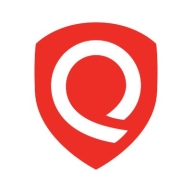
![Threat Stack Cloud Security Platform [EOL] Logo](https://images.peerspot.com/image/upload/c_scale,dpr_3.0,f_auto,q_100,w_64/o0no0it6ybl6satjcxomcblsgmd6.png?_a=BACAGSDL)
Qualys VMDR and Threat Stack Cloud Security Platform [EOL] compete in vulnerability management and cloud security. Qualys VMDR has the advantage in vulnerability management, while Threat Stack excels in real-time cloud monitoring and workload security.
Features: Qualys VMDR provides extensive vulnerability management, asset visibility, and prioritization capabilities. Threat Stack Cloud Security Platform [EOL] offers robust cloud workload protection, real-time threat detection, and compliance monitoring.
Room for Improvement: Qualys VMDR could improve its integration capabilities with other security tools, enhance user interface customizations, and streamline its reporting features. Threat Stack could benefit from expanded customer support services, deeper integration with third-party tools, and enhanced scalability for larger environments.
Ease of Deployment and Customer Service: Qualys VMDR offers a seamless deployment process with strong customer support. Threat Stack Cloud Security Platform [EOL] is straightforward to deploy but has limited support due to its end-of-life status.
Pricing and ROI: Qualys VMDR has a more attractive pricing model and delivers better ROI through its comprehensive features and support. Threat Stack Cloud Security Platform [EOL] has a less favorable cost-benefit ratio, despite its solid features.
We saw a return on investment through significant savings in time, money, and resources.
We usually get on calls with tech support, and they are very helpful.
The response time takes a while.
Qualys VMDR's scalability is good.
Scalability depends on the license and the number of assets being monitored.
Qualys VMDR can handle scalability, although increasing the inventory can raise the licensing costs.
Qualys VMDR's scalability is good, and the customer support is good.
Qualys VMDR is stable.
It does not automate patching unless the patch management module is purchased separately.
One area where Qualys VMDR can be improved is the missing feature for deploying agents for over 1,000 assets, as we need to do it manually.
If AI features were integrated, it could enhance the capabilities significantly.
I have a notion that Qualys might be more expensive than Rapid7.
I would rate the pricing between seven to eight out of ten.
Qualys offers better pricing and is feature-packed compared to other tools.
The prioritization of vulnerabilities has improved our remediation efforts by around thirty to thirty-five percent.
It impacts my workflow overall, with the patch management features as it has the missing patches listed in detail, making it easier to get a comprehensive report and providing some dashboards that offer visual representation.
Qualys VMDR offers a one-stop solution for monitoring and reporting.
| Company Size | Count |
|---|---|
| Small Business | 20 |
| Midsize Enterprise | 12 |
| Large Enterprise | 69 |
| Company Size | Count |
|---|---|
| Small Business | 2 |
| Midsize Enterprise | 5 |
| Large Enterprise | 2 |
Vulnerability Management, Detection, and Response (VMDR) is a cornerstone product of the Qualys TruRisk Platform and a global leader in the enterprise-grade vulnerability management (VM) vendor space. With VMDR, enterprises are empowered with visibility and insight into cyber risk exposure - making it easy to prioritize vulnerabilities, assets, or groups of assets based on business risk. Security teams can take action to mitigate risk, helping the business measure their actual risk exposure over time.
Qualys VMDR offers an all-inclusive risk-based vulnerability management solution to prioritize vulnerabilities and assets based on risk and business criticality. VMDR seamlessly integrates with configuration management databases (CMDB), Qualys Patch Management, Custom Assessment and Remediation (CAR), Qualys TotalCloud and other Qualys and non-Qualys solutions to facilitate vulnerability detection and remediation across the entire enterprise.
With VMDR, users are empowered with actionable risk insights that translate vulnerabilities and exploits into optimized remediation actions based on business impact. Qualys customers can now aggregate and orchestrate data from the Qualys Threat Library, 25+ threat intelligence feeds, and third-party security and IT solutions, empowering organizations to measure, communicate, and eliminate risk across on-premises, hybrid, and cloud environments.
Threat Stack Cloud Security Platform [EOL] offers robust security features including endpoint monitoring, rule customization, and integration capabilities, with easy connectivity to cloud services like Docker and AWS.
Threat Stack Cloud Security Platform [EOL] provides tools for enhancing security visibility across cloud infrastructure. It supports AWS and Docker integration, facilitating efficient threat detection and management. Users appreciate its capability to configure customizable alerts and monitor endpoints, sessions, API interactions, and cloud services. However, there are areas needing improvement, such as better serverless environment support and reduced alert frequency. The platform services smaller organizations by compensating for limited security resources with its comprehensive monitoring and auditing tools.
What are the key features?In specific industries, Threat Stack Cloud Security Platform [EOL] is utilized for its strength in monitoring cloud infrastructure and preventing unauthorized access. Organizations in fields where cloud operations are critical use it for regular audits and monitoring. Its capabilities in threat management are leveraged to maintain secure operations and compliance, especially where there is no dedicated security team.
We monitor all Container Security reviews to prevent fraudulent reviews and keep review quality high. We do not post reviews by company employees or direct competitors. We validate each review for authenticity via cross-reference with LinkedIn, and personal follow-up with the reviewer when necessary.